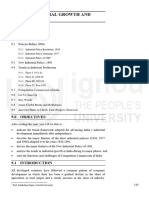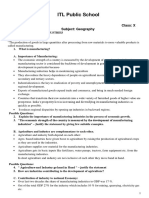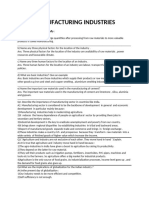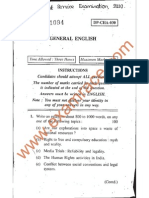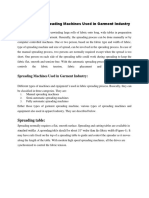Industrial Development: Module - 8
Industrial Development: Module - 8
Uploaded by
Aaron MccallCopyright:
Available Formats
Industrial Development: Module - 8
Industrial Development: Module - 8
Uploaded by
Aaron MccallOriginal Description:
Original Title
Copyright
Available Formats
Share this document
Did you find this document useful?
Is this content inappropriate?
Copyright:
Available Formats
Industrial Development: Module - 8
Industrial Development: Module - 8
Uploaded by
Aaron MccallCopyright:
Available Formats
MODULE - 8
Economic activities
and infrastructural
development in India
195
Industrial Development
GEOGRAPHY
Notes
24
INDUSTRIAL
DEVELOPMENT
The processing of natural resources into more useful items is called manufacturing.
These manufactured goods are finished products derived fromthe raw materials.
These raw materials used in manufacturing industry may be either in their natural
formsuch as cotton, wool, iron ore etc. or may be in the semi processed form like
cotton yarn, pig iron etc. which can further be used for making more useful goods.
Thus the finished product of one industry may serve as the raw material for another
industry. Economic development cannot be achieved by a country without
developing its industries. There is a direct relationship between the level of industrial
development and the economic prosperity of a country. Developed countries like
the USA, Japan, Russia owe due to their prosperity to highly developed industries.
Industrially less developed countries export their natural resources and import
finished goods at higher prices and continue to remain economically backward.
In India manufacturing industries contributed about 30 per cent of the gross domestic
product. These industries provide employment to about 28 million people. Thus
industries are a major source of national income and employment.
In this lesson, we will study different types of industries, their classification and
then distribution in India.
OBJECTIVES
After studying this lesson, you will be able to :
trace the historical development of industries in India;
understand the role of industries in the economic development of our country;
classify the industries on the basis of different criteria;
MODULE - 8 Industrial Development
Economic activities
and infrastructural
development in India
196
GEOGRAPHY
Notes
establish the relationship of industrial development with agriculture, minerals
and energy;
examine the factors affecting the localization of industries;
describe spatial distribution of some major agro-based and mineral based
industries in India;
locate and identify selected industries on the map of India;
explain the role of different policies in augmenting industrial development in
India;
establish the relationship between industrial development and regional
development;
establish the effects of economic liberalization on location and growth of
industries; and
explain impact of industrial development on environment.
24.1 BRIEF HISTORY OF MODERN INDUSTRIES
The modern industrial development in India started with the establishment of the
first cotton textile mill at Mumbai in 1854, predominantly with Indian capital and
entreprenuership. Jute industry made a beginning in 1855 with the establishment
of a jute mill in the Hooghly Valley near Kolkata with foreign capital and
entreprenuership. Coal mining was first started at Raniganj in 1772. Railways
were introduced in 1854. Tata Iron and Steel Plant was set up at Jamshedpur in
1907. Several other medium and small size industries like cement, glass, soaps,
chemicals, jute, sugar and paper followed. The industrial production in pre-
independence period was neither adequate nor diversified.
At the time of independence, the economy was under-developed with agriculture
contributing to more than 60 per cent of the GDP and most of the countrys export
earnings. After 60 years of independance, India has now shown the signs of
becoming a leading economic power.
Industiral development in India can be divided into two phases. The Government
successively increased its control over different economic sectors during the first
phase (1947-1980). In the second phase (1980-97) it took measures to liberalise
the economy between 1980 and 1992. These measures were somewhat adhoc.
After 1992, the whole process of liberalization became more focused and radically
different in nature.
After independence, systematic industrial planning under different five year plans
helped in establishing a large number of heavy and medium industries. The main
thrust of the industrial policy was to remove regional imbalances and to introduce
diversification of industries. Indigenous capabilities were developed to achieve
self sufficiency. It is due to these efforts that India has been able to develop in the
field of industry. Today, we export a large number of industrial goods to various
countries.
MODULE - 8
Economic activities
and infrastructural
development in India
197
Industrial Development
GEOGRAPHY
Notes
INTEXT QUESTIONS 24.1
1. When and where was coal mining first started?
________________________________________________________
2. In which year the railways were introduced in India?
________________________________________________________
3. Where was Tata Iron and steel plant established?
________________________________________________________
24.2 CLASSIFICATION OF INDUSTRIES
Industries can be classified on different basis. Classification of industries on the
basis of five criteria has been given in the following table.
Table No. 24.1 Classification of Industries
Sl.No. Criteria Types of Industries Main characteristics Examples
1. Sources of (i) Agro-based Industries Agricultural products Cotton textile, jute,
Raw Material used as raw materials sugar and paper
industry
(ii) Mineral based Industries Minerals are used as Iron and steel,
raw materials chemical and cement
industry
2. Ownership (i) Public Sector Owned and managed Bokaro iron and steel
by Government plant, Chittaranjan
locomotive works.
(ii) Private Sector Owned and managed Tata Iron and Steel
by an individual or a J .K. cement industry
group as a company Appolo Tyres.
(iii) J oint Sector Owned jointly by public Maruti Udyog
and private sectors
(iv) Cooperative Sector Owned by cooperative Sugar industry in
society of raw material Maharashtra, Amul
producers (Gujarat) and IFFCO
(Kandla)
3. Function or Role (i) Basic Industry Finished products of basic Iron and Steel and
industry are used as raw petro-chemical
material for other industries industries.
(ii) Consumer Goods Finished products of this Toothpaste, soap,
I ndustry industry are directly used sugar industry
by individuals.
4. Size of Industry (i) Large Scale Industry Huge investment, heavy Iron and steel,
machinery, large number oil refineries,
of workers, large factory,
24 hours operation.
MODULE - 8 Industrial Development
Economic activities
and infrastructural
development in India
198
GEOGRAPHY
Notes
This is not necessary for any particular industry to be included only in one category.
Depending upon the classification, the same industry can become an example of
different types of industries. For example, Bokaro Iron and Steel plant is a mineral
based industry. It is in public sector. It is a basic industry. It is large scale industry
and also an example of heavy industry.
INTEXT QUESTIONS 24.2
1. Which one of the following industries belongs to public sector?
(i) J.K. Cement
(ii) Tata Iron and Steel Plant
(iii) Bokaro Iron and Steel Plant
(iv) Raymonds Synthetics
2. Which one of the following is a consumer industry?
(i) Petro-chemicals.
(ii) Iron and steel
(iii) Chittranjan Locomotives
(iv) Sugar Industry
3. Which one of the following is a small scale industry?
(i) Sugar
(ii) Paper
(iii) Cotton
(iv) Ceiling Fans
4. Name five criteria under which industries can be classified.
1. ___________ 2. ___________ 3. ___________
4. ___________ 5. ___________
(ii) Small Scale Small investment, small cycles,
Industries factory, few factory electrical goods
workers industry
(iii) Rural and owned by family J ewellery,
Cottage Industries members, small handicrafts,
machine at homes handlooms, art work
5. Weight of (i) Heavy Industries Both raw material and Iron and steel,
Raw Materials finished products are BHEL (Hardwar):
and Finished heavy and bulky, heavy electrical
Products high transport cost like generator.
(ii) Light Industries Both raw material and Watches,
finished products are readymade garments,
light in weight, low toys, fountain pens.
transport cost.
MODULE - 8
Economic activities
and infrastructural
development in India
199
Industrial Development
GEOGRAPHY
Notes
24.3 AGRO-BASED INDUSTRIES
Textiles, sugar, paper and vegetable oil industry are some of the examples of agro-
based industries. These industries use agricultural products as their raw materials.
Textile industry is the largest industry in the organized sector. It comprises of (i)
cotton textiles, (ii) woolen textiles, (iii) silk textiles (iv) synthetic fibres and (v) jute
textile industries. Textiles has been a major component of the industrial sector. It
accounts for nearly a fifth of the industrial output and a third of the export earnings.
In termof employment, it comes next only to agriculture sector.
(A) COTTON TEXTILE INDUSTRY
The industrial development in India began with the establishment of first successful
modern cotton textile mill at Mumbai in 1854. Since then the industry has witnessed
a phenomenal growth. The numbers of mills increased from378 in 1952 to 1782
by March 1998.
Cotton textiles has an important place in the economy of the country. It provides
employment opportunities to a large number of people. About one fifth of the total
industrial labour is absorbed by this industry.
(a) Production
Cotton textile industry comprises of three sectors: mill sector, handloom and
powerloom. The share of large mill, handloomand powerloom sector in the total
production of cotton cloth in 1998-99 was 5.4 per cent, 20.6 per cent and 74 per
cent respectively. The cloth production of cotton textile increased from421 crore
square metres in 1950-51 to 1794.9 crore square metres in 1998-99.
The Cotton and synthetic fibre textile industry has made tremendous progress.
Per capita availability of cloth fromboth the types was 15 metres only in 1960-61.
In the year 1995-96, it has risen to 28 metres. This has enabled us to export
cotton yarn, cotton fabrics and cotton and synthetic garments on a large seale. In
1995-96 we earned 2.6 billion dollars by their exports.
(b) Distribution
Cotton textile industry is one of the most widely distributed industries in our country.
These mills are located in more than 88 centres in different parts of the country.
But majority of cotton textile mills are still located in the cotton growing areas of
the great plains and peninsular India. (Fig 24.1)
MODULE - 8 Industrial Development
Economic activities
and infrastructural
development in India
200
GEOGRAPHY
Notes
Fig. 24.1: India : Centres of Textile Industry
Maharashtra is the leading producer of cotton textile in the country. Mumbai is the
major centre of textile mills. About a half of the Cotton textile mills are located in
Mumbai alone. It is, therefore, rightly called as Cottonpolis of India. Sholapur,
Kohlapur, Nagpur, Pune, Aurangabad and Jalgaon are other important centres in
Maharashtra.
Gujarat, which ranks second in the production of cotton textiles, Ahamedabad is
the major centre of the state. Surat, Bharauch, Vadodara, Bhavnagar and Rajkot
are other centres in the state.
Tamil Nadu has emerged as an important producer of cotton textiles in sourthern
states. Coimbatore is an important centre in the state. Tirunelveli, Chennai, Madurai,
Tiruchirapalli, Salemand Thanjavour are other important centers here.
MODULE - 8
Economic activities
and infrastructural
development in India
201
Industrial Development
GEOGRAPHY
Notes
In Karnataka, cotton textile industry is concentrated at Bangalore, Mysore, Belgaum
and Gulberga. Kanpur, Etawah, Modinagar, Varanasi, and Hathras are important
centres in Uttar Pradesh. In MadhyaPradesh this industry is concentrated at Indore
and Gwalior. Howrah, Serampur and Murshidabad are important Cotton textile
centres in West Bengal.
Rajasthan, Punjab, Haryana and Andhra Pradesh are the other states producing
cotton textiles.
The following are the factors for the localization of textile industry in Ahmedabad
Mumbai Pune region.
1. Availability of raw material A large amount of cotton is grown in this belt.
2. Availability of capital Mumbai, Ahmedabad and Pure are the places where
capital for investment is easily available.
3. Means of transport This region is well connected with the rest of India by
roads and railways. It, therefore, facilities transportation of finished products.
4. Accessibility to the market Maharashtra and Gujarat has a large market to
sell textile products here. Developed means of transportation help in movement
of textile products to other market centres as well as to foreign market. Now
a days the market has become a domimant factor in determining the location
of cotton textile industry.
5. Nearness to ports Mumbai port facilitates the import of machinery and
good quality of cotton fromabroad and export of the finished products.
6. Cheap labour Cheap and skilled labour is easily available from the
surrounding areas.
7. Availability of power Cheap and sufficient power is easily available here.
B. SUGAR INDUSTRY
Sugar industry is the second largest agro-based industry of India. If we take Gur,
Khandsari and Sugar together, then India becomes the largest producer of sugar
product in the world. In 2003, there were about 453 sugar mills in the country.
This industry employs about 2.5 lakh people.
(a) Production
The production of sugar depends upon the production of sugarcane and it fluctuates
with the fluctuations in the production of sugarcane. The total sugar production in
1950-51 was 11.3 lakh tonnes. It increased to 201.32 lakh tonnes in 2002-2003.
In 2003-04, it fell down to 138 lakh tonnes.
(b) Distribution
Most of the sugar mills are concentrated in six states, namely Uttar Pradesh, Bihar,
Maharashtra, Tamil Nadu, Karnataka and Andhra Pradesh.
MODULE - 8 Industrial Development
Economic activities
and infrastructural
development in India
202
GEOGRAPHY
Notes
Uttar Pradesh It holds a significant position in the production of sugar. The
sugar mills are highly concentrated in the western Uttar Pradesh in the districts of
Meerut, Muzaffar Nagar, Saharanpur, Bijnor, Moradabad and Bulandshahar. In
the eastern Uttar Pradesh Deoria, Basti, Gonda and Gorakhpur are important
centres. Uttar Pradesh has largest area under sugarcane cultivation. It has about
half of the total area under sugarcane cultivation. But it was able to produce only
one third of the total production of sugar (2003-04) in the country. Evidently, per
hectare production as well as sugar contain in produce are relatively low.
Maharashtra Maharashtra is the most important state in the peninsular India
producing about one fourth of the total sugar production in India. Major centres of
sugar production are Nasik, Pune, Satara, Sangli, Kolhapur and Sholapur.
Andhra Pradesh East and West Godawari, Visakha-pattnam, Nizamabad,
Medak and Chittoor districts are the centres of sugar mills in this state.
Tamil Nadu In Tamil Nadu North and South Arcot, Madurai, Coimbatore and
Tiruchirapalli are the important districts for sugar production.
Karnataka It is also an important sugar producing state. Belgaum, Mandya,
Bijapur, Bellary, Shimonga and Chitradurga are sugar producing districts.
Bihar, Gujarat, Punjab, Haryana, and Rajasthan are other states where sugar mills
are located.
The following are the factors for the localization of sugar industry
1) Sugarcane is the main raw material for making sugar. Sugar mills can be set
up only in the sugarcane producing areas. Sugarcane gets dry soon after
harvesting. It can neither be stored nor kept for long period of time. Sugarcane
should be taken immediately to the sugar mills after harvesting.
2) Transportation cost of sugarcane is high. Generally sugarcane is transported
through bullock carts which can carry it upto 20-25 kilometers. Recently
tractor trolleys and trucks have been used to carry sugarcane to the sugar
mills.
Beside these factors, capital, market, labour and power also play significant
role in localization of this industry.
Reasons for shifting of sugar industry from North India to Peninsular India
Over the period, sugarcane industry is gradually shifting from north Indian states
to states in Peninsular India. Some of the important reasons are as follows:
1) The production of sugarcane per hectare is higher is Peninsular India. In fact,
sugarcane crop grows well in the tropical climate of south India.
MODULE - 8
Economic activities
and infrastructural
development in India
203
Industrial Development
GEOGRAPHY
Notes
2) The sucrose contents is higher in the tropical variety of sugarcane grown in
the south.
3) The crushing season in south India is longer than in north India.
4) In south India most of the mills have modern machinery.
5) Most of the mills in Peninsular India are in cooperative sector, where profit
maximization is not the sole objective.
Agro-based industries use agricultural products as their raw material.
Cotton textile industry is the largest industry of organised sector in India.
Cotton textile industry is widely distributed in India.
Large number of sugar mills are located in Maharashtra, Uttar Pradesh,
Tamil Nadu, Karnataka, Andhra Pradesh, Gujarat and Bihar.
INTEXT QUESTIONS 24.3
1. When and where was first modern Cotton textile mill established?
________________________________________________________
2. How much is the share of powerloomin the total production of cotton textiles
in India?
________________________________________________________
3. Which state is the leading producer of cotton textiles in India?
________________________________________________________
4. State any three reasons behind the shifting of sugar industry fromnorth India
to south India.
1. ______________________________________________________
2. ______________________________________________________
3. ______________________________________________________
24.4 MINERAL BASED INDUSTRIES
Industries which use minerals as the raw material are called mineral based industries.
Iron and steel industry is the most important among these industries. Engineering,
cement, chemical and fertilizer industries are also important mineral based industries.
Sl. Name of Locati on Owner- Raw Material obtained from
No. the plant ship Coal/power I ron-Ore Limestone Manganese
1. TISCO J amshedpur Private J haria Mayurbhanj Keonjhar Singhbhumi
Sector Singhbhumi
2. IISCO Burnpur Public J haria/ Singhbhumi Keonjhar Singhbhumi
Sector DVC Mayurbhanj
3. VISL Bhadrawati Public Sharavati Kemaman- Bhandiguda Chitradurga
Sector Proj ect gundi Shimoga
4. HSL Rourkela Public Bokaro/ Sundargarh Pumapani Bara J amda
Sector J haria/ Keonjhar
Hirakud
Proj ect
5. HSL Bhilai Public Kargali, Dalli- Nandini Balaghat
Sector Korba Rajhara
A. IRON AND STEEL INDUSTRY
Iron and steel industry is a basic industry and its products serve as a raw material
for a number of other industries.
Although iron and steel manufacturing activity in India is very old, modern iron and
steel industry started with the establishment of Bengal Iron and Steel Works at
Kulti in West Bengal in 1817. Tata Iron and Steel company was established at
Jamshedpur in 1907. This was followed by Indian Iron and Steel plant at Burnpur
in 1919. All the three plants were established in the private sector. The first public
sector iron and steel plant, which is now known as Visvesvarayya Iron and Steel
works, was established at Bhadrawati in 1923.
The iron and steel industry made rapid progress after independence. The production
capacity has increased in all the existing units. Three new integrated steel plants
were established at Rourkela, Bhilai and Durgapur. Bokaro steel plant was
established under public sector in 1964. Bokaro and Bhilai plants were set up
with the collaboration of the former Soviet Union. Durgapur steel plant was set up
in Collaboration with United Kingdomwhile Rourkela plant was established with
the help of Germany. Vishakhapattnam and Salemplants were set up afterwards.
At the time of independence, India produced only a small quantity of iron and
steel. Production of finished steel in the country was only 10-lakh tonnes in 1950-
51 which has increased to 23.8 million tonnes in 1998-99.
The major iron and steel plants of India are situated in the states of Jharkhand,
West Bengal, Orissa, Chhattisgarh, Andhra Pradesh, Karnataka and Tamil Nadu.
Besides there are about 200 mini steel plants in India with a capacity of 6.2 million
tonnes per annum. Mini steel plants produce steel from scrap or sponge iron.
These units constitute an important component of iron and steel industry in the
country.
Most of the steel plants are located in and around Chhota Nagpur plateau which
is endowed with rich deposits of iron ore, coal, manganese and limestone. The
details of raw material, ownership and location is given in the following table:-
Table No. 24.2 : INDIA : Iron and Steel Plants and their source of raw materials
Fig. 24.2: India : Iron and Steel Plants
6. HSL Durgapur Public J haria/DVC Bolangiri Birmitrapur J amda
Sector (Keonjhar) (Sundargarh) (Keonjhar)
7. BSL Bokaro Public J haria/ Kiriburu Palamau Barakar
Sector DVC in Keonjhar
Distt.
8. SSP Salem Public Neyveli Salem Distt. Salem Distt. Salem Distt.
Sector
9. VSL Vishakha Public Damodar Bailadila, Chhattisgarh Balaghat
Pattnam Sector Valley Chhattisgarh and MP
MODULE - 8
Economic activities
and infrastructural
development in India
205
Industrial Development
GEOGRAPHY
Notes
MODULE - 8 Industrial Development
Economic activities
and infrastructural
development in India
206
GEOGRAPHY
Notes
The information regarding availability of raw material given in the above mentioned
table can also be refered with the figure no. 24.2.
INTEXT QUESTIONS 24.4
1. State the place of location and the year of establishment of Bengal Iron and
Steel Works?
________________________________________________________
2. In collaboration of which country, the Durgapur steel plant was established?
________________________________________________________
3. Which one of the following steel plants is located in the state of Andhra
Pradesh?
A) Durgapur B) Bokaro C) Bhilai D) Vishakhapattnam
4. Which one of the following steel plants is in private sector?
A) Burnpur B) Bhadrawati C) Jamshedpur D) Bhilai
24.5 PETRO-CHEMICALS INDUSTRY
Petro-chemicals industry is one of the fastest growing industries of India. This
industry has revolutionised the industrial scene by providing the products which
are substituting the traditional raw materials like wood, glass and metals. Its products
meet various needs of the people at the low cost. Petro-chemicals are derived
from petroleum or natural gas. We use a variety of products from morning till
evening made frompetrochemicals Toothbrushes, toothpaste, combs, hairpins,
soap cases, plastic mugs, garments, radiocaes, ball point pens, detergents, electric
switches, lipstick, insecticides, bags, bed covers, and foamare some of the goods
made frompetro-chemicals.
Indian Petro-Chemical Corporation has set up a huge petro-chemical complex
near vadodara producing a wide range of products. Besides Vadodara, Gandhar,
and Hazira in Gujarat and Nagathone in Maharashtra are other important centres
of petro-chemical industry. India is self sufficient in the production of petro-
chemicals.
Crude oil has no value unless it is refined, while refining crude oil, thousands of
products like kerosene, diesel, lubricants and raw material for petro-chemical
industry are derived. India has at present 18 refineries.
These refineries are at Digboi, Bongaigaon, Nunamati (All are in Assam), Mumbai
(two) (Maharashtra), Visakhapatnam(Andhra Pradesh), Barauni (Bihar), Koyali
(Gujarat), Mathura (U.P.), Panipat (Haryana), Kochi (Kerala), Mangalore
MODULE - 8
Economic activities
and infrastructural
development in India
207
Industrial Development
GEOGRAPHY
Notes
(Karnataka) and Chennai (Tamil Nadu). The only private oil refineries belongs to
Reliance Industries Ltd. is located at Jamnagar (Gujarat).
INTEXT QUESTIONS 24.5
1. Mention three important raw materials substituted by petro chemicals?
1._____________ 2._____________ 3._____________
2. Where has Indian Petrochemical Corporation been headquartered?
________________________________________________________
3. Write one centre of Petro chemical industry in Maharashtra state.
4. Match the following
A B
(a) Nunmati (i) Kerala
(b) Kochi (ii) Assam
(c) Karnal (iii) Bihar
(d) Barauni (iv) Haryana
24.6 INDUSTRIAL CLUSTERS
There are regional variations in the levels of industrial development in India. Indian
industries have concentrated in clusters at some locations. Most industrial regions
in India have developed in the hinterlands of some major ports like Kolkata, Mumbai
and Chennai. These industrial regions have all the advantages like availability of
raw materials, energy, capital and markets. Six major industrial regions emerged
out of which three are in the hinterlands of ports. The six major industrial regions
are as follows:-
1. Hooghly Industrial region
2. Mumbai Pune Industrial region
3. Ahmedabad Vadodera region
4. Madurai Coimbatore Banglore region
5. Chhota Nagpur plateau region
6. Delhi and Adjoining region
Besides these major industrial regions, there are 15 minor industrial regions and
15 industrial districts.
24.7 INDUSTRIAL SELF RELIANCE
Industrial self reliance means that the people of India establish and operate industries
MODULE - 8 Industrial Development
Economic activities
and infrastructural
development in India
208
GEOGRAPHY
Notes
with their own technical knowledge finances and using machines manufactured in
our own country without depending on others.
The Govt of India formulated an industrial policy in 1956 with the objectives of
increasing industrial output, generating employment, disperesal of industries,
removing regional imbalances in the industrial development and the development
of village and small scale industries.
Through planned development of Industries, we now manufacture several types
of industrial goods. A major breakthrough has been achieved in the production of
capital goods. India is now self reliant in the production of heavy machines and
equipment used in mining, irrigation, power projects, transport and communication.
We use machines fabricated in India for cement, textile, iron and steel and sugar
industries etc..
Public sector has played an important role in achieving industrial self reliance. Iron
and steel, railway equipment, petroleum, coal and fertilizer industries, have been
developed in this sector. These industries were established in industrially backward
regions. During the seventh five year plan an emphasis was laid on high technology,
high value addition and knowledge based industries like electronics, advanced
machine tools and telecommunications.
24.8 IMPACT OF ECONOMIC LIBERALIZATION
The process of industrialization in India can be divided into two parts before and
after 1992. During first forty years after independence the Indian economy had
diversified and expanded very fast. But this growth was characterized by rigid
controls and regulations.
In August 1992, Government of India took a bold step by changing its economic
policies from state control to market forces. A need was felt to give more
responsibility to private capital and enterprise, both domestic as well as foreign. In
reponse to this, the new industrial policy of liberalization, privatisation and
globalization was adopted in August 1992. The immediate cause of this changes in
economic policy was to tide over balance of payment crises but having wide social,
economic, political and geographical implications.
Liberalization means a reduced role for the Government and a greater role for the
market or the liberal attitude of the Government for the establishment and running
of industries. It was touted as a panacea for the ills of Indian economy. However,
after 15 years of following the path of literalization, the results are not that sweet.
The gap between the rich and the poor has increased. Production of goods of
mass consumption has not improved. Employment opportunities have not increased
at the desired rate. In privatisation there will be transfer of the ownership of public
enterprises to private capital, opening of more industrial areas to private capital
and enterprise. The main aim of privatisation is to make use of privately owned
resources for collective welfare of the people.
MODULE - 8
Economic activities
and infrastructural
development in India
209
Industrial Development
GEOGRAPHY
Notes
Globalization which stands in the current phase for increasing integration between
different economies of the world. The economic gap between different nations is
reduced by removing all restrictions between nations on the movement of goods,
services, capital and technology.
Globalization has made significant impact on consumption patterns and life style of
the people. Now a days the whole world has become a market. Globalization has
also affected on value system.
INTEXT QUESTIONS 24.6
1. When did India formulated its first industrial policy?
________________________________________________________
2. Mention any three industries on which emphasis has been laid in the VII five
year plan.
________________________________________________________
3. What is meant by liberalization?
________________________________________________________
WHAT YOU HAVE LEARNT
The processing of natural resources into more useful items is called manufacturing.
Economic development of a country is directly linked with the level of industrial
development. In India the share of manufacturing industries in GDP has been
increasing, over the peried, especially in post-economic reforms period. Before
independence, India was industrially less developed. But after independence India
initiated industrial development in a planned manner during its Five Year Plans.
Today, India exports a large number of industrial goods to different countries of
the world.
Industries can be classified into different categories on the basis, such as of sources
of raw material, ownership, functions, size of industry and weight of raw material
and finished products. Since India is still an agricultural country, it has developed
various agro-based industries such as cotton textile, woolen textile, jute textile and
sugar industry. Cotton textile industry is the largest organised sector industry in
India. India is also endowed with various minerals, enabling the country to establish
various mineral based industries such as iron and steel, heavy engineering,
automobiles, chemicals and petro chemical industry.
The Government of India framed policies which have made India self reliant in
various sectors of industries. Liberalization, globalization and privatization have
MODULE - 8 Industrial Development
Economic activities
and infrastructural
development in India
210
GEOGRAPHY
Notes
helped in bringing foreign capital and modern technology into the country. Private
enterprise is being allowed to enter into various core sectors. This, has resulted
into the faster growth of industrial sector.
TERMINAL QUESTIONS
1. Why is the cotton textile industry mainly concentrated in and around Mumbai?
Give four reasons.
2. State three reasons for the shifting of sugar industry fromnorth India to south
India.
3. Giving suitable examples, classify industries on the basis of ownership.
4. Define industrial self reliance. Why does India need industrial self reliance.
5. Describe any four factors responsible for the concentration of iron and steel
industry in and around Chhotanagpur plateau.
6. Differentiate between agro-based and mineral based industries. Give two
examples of each.
ANSWERS TO INTEXT QUESTIONS
24.1
1. 1772, Raniganj
2. 1854
3. Jamshedpur
24.2
1. (iii)
2. (iv)
3. (iv)
4. Source of raw material, ownership, function, size of industry, weight of
raw material and finished products. (Any five)
24.3
1. 1854, Mumbai
2. 74%
3. Maharashtra
4. High production of sugarcane/hectare
Higher sucrose content
Longer crushing season
MODULE - 8
Economic activities
and infrastructural
development in India
211
Industrial Development
GEOGRAPHY
Notes
Modernized and well equipped machinery
Mills in cooperative sector (any three)
24.4
1. Kulti in West Bengal, 1817
2. United Kingdom
3. D
4. C
24.5
1. Wood, Glass, Metals
2. Vadodara
3. Negathone
4. (a) and (ii), (b) and (i), (c) and (iv), (d) and (iii)
24.6
1. 1956
2. Electronics, advanced machine tools and telecommunications
3. Reduced role of government and greater role of market.
HINT TO TERMINAL QUESTIONS
1. Refer to 24.3A
2. Refer to 24.3B
3. Refer to 24.2 (Table 1)
4. Refer to 24.7
5. Refer to 24.4
6. Refer to 24.2 (Table 1)
You might also like
- 10.4324 9781003216261 PreviewpdfDocument40 pages10.4324 9781003216261 PreviewpdfmeitaNo ratings yet
- Manual Whirlpool AWSX 63213Document2 pagesManual Whirlpool AWSX 63213Marius Dedal0% (1)
- ch24 PDFDocument17 pagesch24 PDFRanjan Rasmi ParidaNo ratings yet
- Manufacturing Ind Notes2024Document10 pagesManufacturing Ind Notes2024aadyaag2009No ratings yet
- Geography, L-6, Manufacturing IndustriesDocument14 pagesGeography, L-6, Manufacturing IndustriesKrish JainNo ratings yet
- 10 Social Geography Imp ch6 3Document18 pages10 Social Geography Imp ch6 3pothank14No ratings yet
- Class 10 Social Science Notes for Session 2024-25 Chapter - 6 Manufacturing_IndustriesDocument49 pagesClass 10 Social Science Notes for Session 2024-25 Chapter - 6 Manufacturing_IndustriesmougliprafulNo ratings yet
- Manufacturing Industries - GeographyDocument18 pagesManufacturing Industries - GeographyKeshav PareekNo ratings yet
- Manufacturing Industries Class 10Document20 pagesManufacturing Industries Class 10harshitparmarjhs07No ratings yet
- CBSE Class 8 Geography Chapter 5 Notes - IndustriesDocument9 pagesCBSE Class 8 Geography Chapter 5 Notes - IndustriesRamya krovvidyNo ratings yet
- Manufacturing Industries Term 2 NotesDocument7 pagesManufacturing Industries Term 2 Notesbrownmunde9367.phNo ratings yet
- CH 5 Industrial PolicyDocument34 pagesCH 5 Industrial Policynayak RashmitaNo ratings yet
- Manufacturing IndustriesDocument4 pagesManufacturing IndustriesChirag PadhiyarNo ratings yet
- IndustriesDocument3 pagesIndustriesDisha SharmaNo ratings yet
- Block 3Document38 pagesBlock 3pratishtha.singh2602No ratings yet
- CH 6 Manufacturing IndustriesDocument7 pagesCH 6 Manufacturing IndustriesSK ABDUR REHMAN (SK)No ratings yet
- Ch6 Manufacturing Industries FinalDocument8 pagesCh6 Manufacturing Industries Finalpushkararyan08No ratings yet
- Unit 9Document18 pagesUnit 9Sreelatha VanacharlaNo ratings yet
- ITL Public School: Class: X Subject: GeographyDocument6 pagesITL Public School: Class: X Subject: GeographyMahiNo ratings yet
- Iron and Steel IndustryDocument16 pagesIron and Steel Industrykhadija khanNo ratings yet
- Industrial Growth 1st ChapterDocument18 pagesIndustrial Growth 1st ChapterAbhishek SahuNo ratings yet
- Industries in IndiaDocument13 pagesIndustries in IndiaArvind RanganathanNo ratings yet
- Significance and Future Prospects of Textile Exports in Indian EconomyDocument18 pagesSignificance and Future Prospects of Textile Exports in Indian EconomyRaja JaisinghNo ratings yet
- The Indian Industrial Scenario: Chapter-IDocument29 pagesThe Indian Industrial Scenario: Chapter-IBini VgNo ratings yet
- Geography Unit-6 Manufacturing IndustriesDocument14 pagesGeography Unit-6 Manufacturing Industriessanskar.alternativeNo ratings yet
- Industries in IndiaDocument16 pagesIndustries in IndiaJai ShankarNo ratings yet
- Manufacturing IndustriesDocument10 pagesManufacturing IndustriesManas Das100% (1)
- NOTESDocument7 pagesNOTESpranshuplaysNo ratings yet
- Manufacturing in IndianDocument19 pagesManufacturing in IndianshuklakcmtNo ratings yet
- Study Material Question Bank and Answer Key Geo: Manufacturing IndustriesDocument23 pagesStudy Material Question Bank and Answer Key Geo: Manufacturing IndustriessaanviNo ratings yet
- Manufacturing IndustriesDocument6 pagesManufacturing Industriesmanjiri0380No ratings yet
- Achievers Academy Class X Geo CH 6 Worksheet 3Document7 pagesAchievers Academy Class X Geo CH 6 Worksheet 3suryabhan kumarNo ratings yet
- Agro Based IndustriesDocument7 pagesAgro Based Industrieskuldeep9034.patelNo ratings yet
- X STD Geo Le-6 ModofiedDocument17 pagesX STD Geo Le-6 ModofiedHema LathaNo ratings yet
- Manufacturing Industries Notes - Part 1Document6 pagesManufacturing Industries Notes - Part 1lolidontcare390No ratings yet
- NCERT Solutions For Class 8 Social Chapter 4 Industries.Document5 pagesNCERT Solutions For Class 8 Social Chapter 4 Industries.swarnodipdutta8No ratings yet
- 1 3 3 1 5Document10 pages1 3 3 1 5Rakesh SinghNo ratings yet
- UNIT-05 Industrial Patterns During The Five Year Plans in IndiaDocument8 pagesUNIT-05 Industrial Patterns During The Five Year Plans in IndiaSAJAHAN MOLLANo ratings yet
- GeographyDocument8 pagesGeographyAkshay ShettarNo ratings yet
- What Is Manufacturing?Document4 pagesWhat Is Manufacturing?Rhea JohnNo ratings yet
- Geography Revision Notes Manufacturing IndustriesDocument4 pagesGeography Revision Notes Manufacturing Industriespjain73723No ratings yet
- AGRO BASED INDUSTRIES NOTES 2022Document15 pagesAGRO BASED INDUSTRIES NOTES 2022Aayush AteNo ratings yet
- CONLIB - Ch6 - 20231109105212 2Document13 pagesCONLIB - Ch6 - 20231109105212 2vq69tzctjqNo ratings yet
- Manufacturing IndustriesDocument4 pagesManufacturing IndustrieshelloNo ratings yet
- Hess 405Document16 pagesHess 405Shriram NarakasseryNo ratings yet
- Ass 10 Extra Questions GeographyDocument66 pagesAss 10 Extra Questions Geographysuddalas106No ratings yet
- MANUFACTURING INDUSTRIES_NOTES (2)Document9 pagesMANUFACTURING INDUSTRIES_NOTES (2)hamza.tbmdNo ratings yet
- Ncert Indian Manufacturing SectorDocument19 pagesNcert Indian Manufacturing SectorPraveen JhaNo ratings yet
- Class: X Manufacturing Industries Sub: Geography. Date: 19.11.22 Ncert Based Exercises-Answer The FollowingDocument5 pagesClass: X Manufacturing Industries Sub: Geography. Date: 19.11.22 Ncert Based Exercises-Answer The Followingmrprathyu13No ratings yet
- Important Study MaterialDocument6 pagesImportant Study MaterialchampionNo ratings yet
- Mnaufacturing Industries (Agro-Based)Document7 pagesMnaufacturing Industries (Agro-Based)Anupam RoyNo ratings yet
- Industry NotesDocument4 pagesIndustry Notesvipra.agarNo ratings yet
- Manufacturing Industries NotesDocument8 pagesManufacturing Industries Notesx.makiyana.xNo ratings yet
- Manufacturing Industries: Multiple Choice QuestionsDocument15 pagesManufacturing Industries: Multiple Choice QuestionsshiniiiNo ratings yet
- IndustriesDocument3 pagesIndustrieshrishikeshsaha2020No ratings yet
- Manufacturing Industries CorrectedDocument12 pagesManufacturing Industries CorrectedChanduNo ratings yet
- IndustryDocument2 pagesIndustrypriyam duttaNo ratings yet
- LN 6 Manufacturing Industries 2024Document8 pagesLN 6 Manufacturing Industries 2024fidanissark08No ratings yet
- Environment 9Document21 pagesEnvironment 9soundu ranganathNo ratings yet
- Geography Chapter 6 Manufacturing IndustriesDocument24 pagesGeography Chapter 6 Manufacturing Industriesmanitchaudhary8224No ratings yet
- Industries - Class 8Document4 pagesIndustries - Class 8Meenakshi GuptaNo ratings yet
- IFS General English 2010Document8 pagesIFS General English 2010Aaron MccallNo ratings yet
- IFS General English 2009Document7 pagesIFS General English 2009Aaron MccallNo ratings yet
- IFS Forestry 2010Document8 pagesIFS Forestry 2010Aaron MccallNo ratings yet
- I I I I: O-Vsf.:.L - SbaDocument12 pagesI I I I: O-Vsf.:.L - SbaAaron MccallNo ratings yet
- History CausesEventsEffectsDocument2 pagesHistory CausesEventsEffectsAaron MccallNo ratings yet
- Lunar SlidesDocument6 pagesLunar SlidesAaron MccallNo ratings yet
- Sublimation Heat Press Quick Guide 1Document2 pagesSublimation Heat Press Quick Guide 1renato jr baylasNo ratings yet
- TT1 2lecture SpinningDocument29 pagesTT1 2lecture SpinninghaiNo ratings yet
- DLL Dressmaking-10Document8 pagesDLL Dressmaking-10Geraldine DaguploNo ratings yet
- Textile TestingDocument49 pagesTextile TestingHappyness Diary Official100% (1)
- An Overview of Knitting Industry of India PDFDocument18 pagesAn Overview of Knitting Industry of India PDFBastinNo ratings yet
- Fabric Inspection: Jimmy K.C. Lam The Hong Kong Polytechnic UniversityDocument25 pagesFabric Inspection: Jimmy K.C. Lam The Hong Kong Polytechnic UniversityAmmar Naeem BhattiNo ratings yet
- Innovative Housing: The Future of Refugee CampsDocument17 pagesInnovative Housing: The Future of Refugee CampsV EstilloreNo ratings yet
- Tensile Fabric StructuresDocument10 pagesTensile Fabric StructuresMoonzeNo ratings yet
- E11-15 Standard Specification For Woven Wire Test Sieve Cloth and Test SievesDocument9 pagesE11-15 Standard Specification For Woven Wire Test Sieve Cloth and Test SievesJosé Luis Celis TejadaNo ratings yet
- Dye Pits and Its Economic Contributions in Nigeria's Post-Pandemic EraDocument8 pagesDye Pits and Its Economic Contributions in Nigeria's Post-Pandemic EraCentral Asian StudiesNo ratings yet
- List of CategoriesDocument38 pagesList of CategoriesBizyWizy Free ClassfiedNo ratings yet
- For Learners: First Quarter Week 1Document22 pagesFor Learners: First Quarter Week 1Naliene RamboNo ratings yet
- Faults of Knit Fabric Observed in Textile Manufacturing IndustryDocument29 pagesFaults of Knit Fabric Observed in Textile Manufacturing IndustryRahatNo ratings yet
- Kapok Fiber InfoDocument3 pagesKapok Fiber InfoErfan TanhaeiNo ratings yet
- Chapter 60Document13 pagesChapter 60Balaji RaoNo ratings yet
- Toko CareManual 2014 ENDocument17 pagesToko CareManual 2014 ENalNo ratings yet
- 10 Fabrics Used in Sport Wear 1 Lycra: SportswearDocument9 pages10 Fabrics Used in Sport Wear 1 Lycra: SportswearTejaswini SinghNo ratings yet
- Original Article in PDF Format (No Numbered Headings)Document13 pagesOriginal Article in PDF Format (No Numbered Headings)helena garcia riosNo ratings yet
- Prospectus Department of Training & Technical EducationDocument54 pagesProspectus Department of Training & Technical EducationUmair SaifNo ratings yet
- Types of Spreading MachineDocument6 pagesTypes of Spreading Machineyasin husen100% (1)
- The Jamaican CherryDocument5 pagesThe Jamaican CherryGemma Joy GimenezNo ratings yet
- Dye ClassDocument60 pagesDye Classimran24100% (3)
- ArahWeave Dobby Quick StartDocument10 pagesArahWeave Dobby Quick StartDušan PetercNo ratings yet
- SpreadingDocument65 pagesSpreadingManuj Shukla100% (1)
- Gcse Textiles Coursework AqaDocument8 pagesGcse Textiles Coursework Aqaswqoqnjbf100% (2)
- Textile Industry in DelhiDocument14 pagesTextile Industry in Delhiaadiveerfabindia09No ratings yet
- Astm D737-2004 (2012) - 0625Document2 pagesAstm D737-2004 (2012) - 0625Deidra CadeNo ratings yet
- PermaGard - Interior - Protection - Warranty - T&CDocument4 pagesPermaGard - Interior - Protection - Warranty - T&CFaith_No_MoreNo ratings yet

















